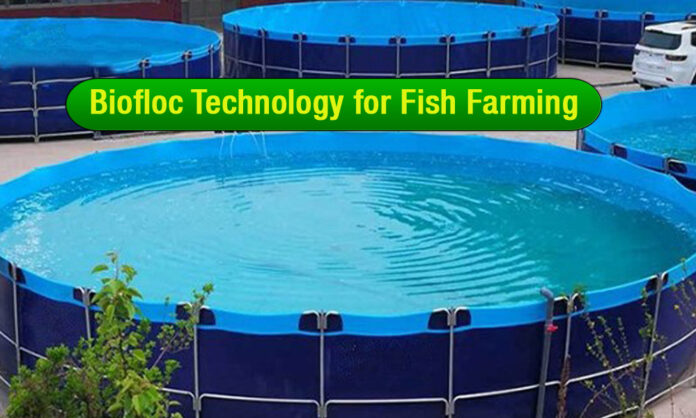MULTAN: With some farmers opting for latest techniques, Biofloc fish farming is yet to click as experts desire more focus and patronage by the authorities to promote this practice on mass scale.
The farmers in South Punjab who practiced this new technique came across hiccups and challenges like provision of uninterrupted power supply, provision of chemicals on affordable prices and overall atmosphere to promote this culture.
But it is fact that Biofloc fish farming attracted farmers and many among them immediately opted for this new technique that recycles waste nutrients as fish feed wherein specifically cultured micro organisms, are mixed with water to form microbial protein from fish waste and other organic matter in the water.
Biofloc is a modern concept of high density fish rearing wherein fish are nurtured in a water tank, made of turbulane sheet. Fish seeds are put into water tank also mixing probiotics (a kind of bacteria) into it to convert materials like Ammonia, Nitrate, and Nitrite into feed. The probiotic in tank consumes ammonia and converts it into protein to be used by fish inside the tank as feed.
Biofloc helps in cleaning the culture water of the fish while giving an additional source of feed. It is a sustainable and eco-friendly process. For Biofloc farming the species must be resistant to environmental changes, tolerant to high stocking density, adapt to changes in dissolved oxygen and be able to take microbial protein as food.
Despite that Biofloc farming can help address the food security issues, some experts are skeptical about its success in our peculiar atmosphere.
“It needs round the clock power supply and oxygen besides chemical(s) to keep the water clean,” says DG Fisheries South Punjab Dr Anser Mahmood Chattha. “Given high power tariff and routine power outages no one can say for sure if the technology was actually viable for doing profitable business.”
Chatha said biofloc fish farming was a special method to produce fish, originally introduced for shrimps in Indonesia and South East Asia and declared it costly as it needed 24 hours supply of energy and oxygen.
He said the fisheries department was further researching on this technology and it would be to clearly say something about the technology’s applicability in south Punjab with business point of view after few years.
“We are also working on other options and start shrimp farming would in next one or two years under public-private partnership as shrimps attract premium price from lucrative markets and investment on biofloc,” he said. “By the time Biofloc fish farming is South Punjab is approximately one per cent of total fish farming.”
There are 20 fish hatcheries operational in the region with seven being run by fisheries department and 13 by private sector.
DG Fisheries was confident that fish farming could become more profitable through value addition and efforts are already on in this direction. “Our department provides farmers 80% subsidy to fish farmers for installation of cage clusters in different rivers.”
Meanwhile, a progressive fish farmer Muhammad Naveed Gul who owns fish farms at Head Muhammad Wala complains of power outage and costly inputs. “I had invested around Rs 1.5 million to develop four 10-marla biofloc water tanks but had to suffer losses due to high cost of inputs, lack of 100 per cent monitoring and inconsistent power supply.”
For instance, he said, in recent days power supply remained suspended for some time and half of the fish seed died. “So I immediately dismantled the system, shifted remaining fish seed into traditional fish ponds from tanks after suffering a loss of hundreds of thousands rupees.”
“I invested in Biofloc after getting information from books and websites. But now I believe, it was very difficult to run this business without government support, proper education and provision of resources.”
He urged the government to come up with plans for solar systems to ensure uninterrupted power supply for biofloc units and reduce cost of inputs including chemicals.
Muhammad Saleem, another fish farmer in Multan also pleaded to lower input prices and proper marketing of fish produced from Biofloc to make this business viable. “The government should come up with a comprehensive strategy to promote this business.”
Among these farmers, some were very confident about success of Biofloc system. “This technology is profit generating and involves lesser cost as failures are mostly result of mistakes and lack of determination,” said Nauman Bodla, a young farmer from Shujabad.
He informed that initially he had set up a couple of tanks in his village but now he has 16 tanks, all operational. “My first year in this business ended with break-even only recovering the cost. Second year was in loss due my own mistakes. But, this year I expect a sizeable profit.”
He said Biofloc needs proper monitoring as initially farmers come across some problems but solutions to these problems also exist. “It would be unwise to disregard the technology as farmers can overcome losses by not repeating their mistakes.”
By the time fish farming spans over 38,000 acre across South Punjab with 2805 registered farmers and this business can further flourish with the patronage of the government and concerned authorities.





















